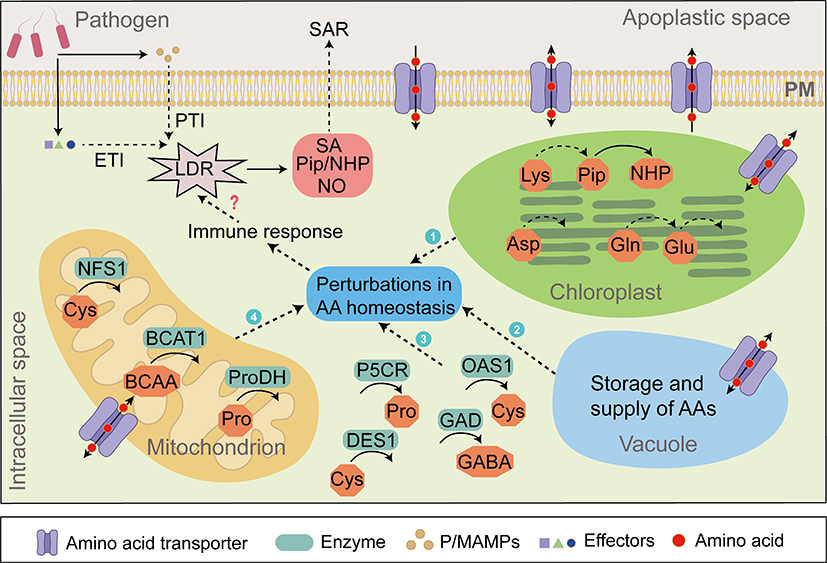Amino acids, as the main form of nitrogen transport in plants, play a crucial role in life activities such as cell division, plant morphogenesis, and physiological metabolism regulation. Amino acid transporters are responsible for the transmembrane transport of amino acids. By regulating amino acid homeostasis, they affect nutrient absorption in plant roots, the growth of above-ground parts, and reproductive development. Research shows that amino acids and amino acid transporters act in concert. They not only participate in plant growth and development but also provide nutrients for pathogen growth. At the same time, they are involved in the plant’s systemic immune response, playing a dual-important role in plant-pathogen interactions.

Recently, the Innovative Team of Cabbage Vegetable Genetics and Breeding at the Institute of Vegetables and Flowers, Chinese Academy of Agricultural Sciences, published an online review article titled “Amino Acid Metabolism and Transporters in Plant-Pathogen Interactions: Mechanisms and Implications” in Plant, Cell & Environment, an internationally renowned journal in the field of plant science (Top in Q1, IF = 6.1).
First of all, this review explored the crucial roles played by the metabolism of related amino acids such as glutamine, proline, γ-aminobutyric acid (GABA), as well as pipecolic acid (Pip) and N-hydroxypipecolic acid (NHP) in the lysine metabolic pathway during the process of plants resisting pathogens. On the one hand, these amino acids can regulate the plant immune response by affecting processes related to nitrogen redistribution and redox balance. On the other hand, the related amino acids and their metabolites can act as signaling substances and directly participate in the plant disease resistance process (Figure 1).

Figure 1. The Role of Amino Acid Metabolism in Plant Disease Resistance
Secondly, this review further summarized the roles of amino acid transporters in plant-pathogen interactions. Taking LHT1 as an example, it affects the homeostasis and redox state of glutamine in leaf mesophyll cells, thus participating in the plant’s defense response. Meanwhile, LHT1 is also involved in transporting amino acids such as β-aminobutyric acid (BABA), affecting the induced resistance of plants. This review also explored the important roles of amino acid transporters in plant-nematode interactions (Figure 2), and discussed the potential synergistic regulatory relationships between amino acid and sugar transporters in plant-pathogen interactions.
Finally, this review proposed that future research should focus on: first, deciphering the perception mechanism of amino acids in plants and clarifying the relationship between amino acid metabolism and immune signaling mechanisms; second, exploring the roles of amino acid transporters in plant disease resistance and susceptibility, including their regulation of amino acid nutrient competition, deciphering the mechanisms by which pathogens regulate transporters, clarifying the relationship between the subcellular and tissue localization characteristics of key transporters and disease resistance/susceptibility, and identifying key coding genes using cutting-edge technologies. This review provides an important reference for in-depth exploration of the regulatory mechanisms of amino acid metabolism and transport on plant-pathogen interactions, and for uncovering key amino acids and amino acid transporters that mediate plant disease resistance. It will contribute to the cultivation of new disease-resistant varieties.

Figure 2. Involvement of Amino Acid Transporters in Plant-Nematode Interactions
The Institute of Vegetables and Flowers, Chinese Academy of Agricultural Sciences, is the first affiliated institution of the paper. Postdoctoral researcher Xuehui Yao is the first author, and Researcher Yangyong Zhang is the corresponding author. Professor Xiaolei Sui from the College of Horticulture, China Agricultural University, provided guidance for this article. This research was funded by the Postdoctoral Fellowship Program of China Postdoctoral Science Foundation and Innovation Program of Chinese Academy of Agricultural Sciences.
Paper link: https://onlinelibrary.wiley.com/doi/full/10.1111/pce.15594